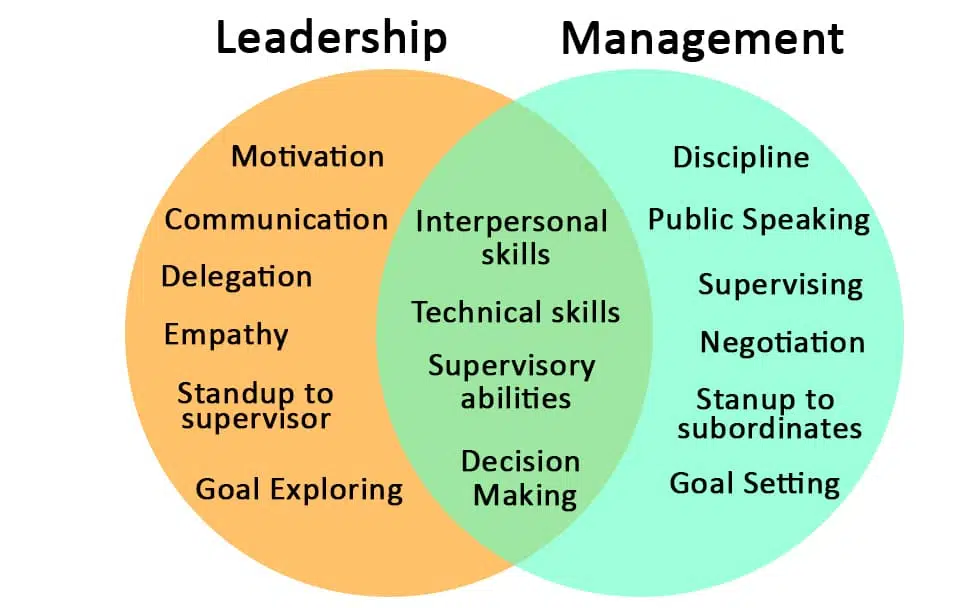I often see professionals using the terms “management” and “leadership” interchangeably. In today’s dynamic business environment, a good manager should also be a good leader. Likewise, a good leader should also be a good manager.
In my over twenty years of experience, I have worked with different managers and leaders. Some were good managers, some were good leaders, and very few were equal in leadership and management.
In today’s blog post, I will explain leadership and management and the difference between these terms.
Leadership and management are different terms and originated at different times. The term “leader” was first used in the 1300s, but researchers focused on it in the late 1930s. The term “manager” first appeared in English in the 1560s, but research didn’t start until the 1920s, a decade before leadership.

What is Leadership?
The ability to guide followers is leadership. It involves influencing, directing, and inspiring followers to take desired actions.
The key characteristics of leadership are sound judgment and employee empowerment. Leadership is not tied to any title, role, or position. You can become a leader with the vision and ability to influence and motivate followers regardless of your role or position in the company. Through the process of leadership, a unified aim is maximized.
What is Management?
Management is about coordinating resources, people, and processes to achieve organizational objectives efficiently. The manager is in charge of organizing, planning, guiding, and overseeing the team’s performance.
According to leadership coach Doc Norton, “Manager is a title. It’s a role and set of responsibilities.” A manager is concerned with team efforts to achieve organizational goals. Organizations give managers the power to instruct team members, hire and fire, promote, reward, and discipline staff based on their performance and behavior.
Leadership Vs Management: Key Differences
Objective
Leadership involves a group of people working toward a single goal: increasing the team’s effectiveness by motivating and assisting them in improving their efficiency. It is a comprehensive process that contributes to an organization’s success rather than an individual accomplishment.
A manager aims to get the most out of a person or group to accomplish a goal while using the least effort. A manager uses people and resources efficiently to achieve a desired result. Management emphasizes finishing tasks and maximizing individual productivity.
Vision
Leaders are visionaries who set long-term goals and ensure the business’s future success. They examine the organization’s existing state, goals, and potential paths to achieving them. They possess the insight to make the necessary transformation.
Managers have a limited perspective compared to leaders because they are concerned with creating a plan to implement a procedure to achieve their business goals. Their vision is limited to carrying out a plan, organizing the activities, and assigning tasks to the team to accomplish the objective.
Position
Leadership has no formal organizational position; you gain it through your behavior and interpersonal skills. It results from your actions in inspiring team members, motivating them to be the best versions of themselves, and helping enhance overall team productivity. Leadership is not linked with any title or position.
Management is a position with a specific job role in an organizational structure. A manager is given a job title with responsibility and a position in the organizational hierarchy.
Function
A leader inspires followers and points them in the right direction to accomplish corporate objectives. In addition to helping team members improve their performance, the team leader leads and solves any problems that may arise during job completion.
A manager’s four responsibilities are planning, leading, regulating, and coordinating tasks. Organizations need managers to boost the productivity and efficiency of their team members, initiatives, and procedures. Managers oversee staff and make decisions on their behalf to accomplish organizational goals.
Focus
Leadership focuses on the “whats” and “whys” of a decision. Leaders try to understand what is happening and its reasoning and then propose solutions to solve the problem. They may even question higher authority if they think the solution is not in their followers’ best interest.
A manager focuses on the “hows” and “whens” of a decision. They do not assess failures; instead, they ensure that each task is carried out as planned. Managers do not try to change the decision process; instead, they support management decisions.
Role of a Leader Vs Role of a Manager
Warren Bennis provided many differences between managers and leaders in his book “On Becoming a Leader.”
Some of the key differences are:
- Managers focus on processes, systems, and structure, while leaders focus on people.
- Managers maintain while leaders develop.
- Managers control, while leaders innovate.
Other differences between the roles of leader and manager are as follows:
Leader
A leader’s job is to inspire and motivate followers and enhance the confidence of team members so they can accomplish the organization’s objectives. A successful leader efficiently handles situations, teams, and organizations.
A leader has the following 10 main functions:
- Coaching and supporting employees to succeed
- Networking with people internally and externally
- Communicating details and information clearly
- Strategizing to tackle projects effectively
- Delegating responsibilities to increase employee productivity
- Motivating the team to perform better
- Being a role model and setting an example to inspire team members
- Training employees to develop and polish their skills
- Adapting to a dynamic work environment to enforce flexibility
- Innovating to improve existing processes and develop more efficient ones
Manager
A manager’s job is to improve their team’s productivity. They develop, manage, and allocate resources optimally to accomplish their goals.
A manager’s role comprises four main functions:
- Planning tasks so that team members know what needs to be done
- Organizing tasks and processes with set timelines
- Leading team members to perform at their best
- Controlling all decisions and ensuring that team members adhere to them
Characteristics of Leaders and Managers
Leaders
- Leaders have a clear understanding of their current position, their next steps, and how they can direct the team to achieve their goals.
- Leaders believe in transparent, clear communication, ensuring harmony among team members.
- Leaders are sincere and hold strong integrity in their team members, organizational goals, and themselves.
- Leaders possess strong inspirational traits to help followers understand their roles and how the team contributes to bigger organizational goals.
- Leaders are born challengers who question wrongdoing without fear.
- Leaders have strong problem-solving abilities and think outside the box to bring unique, practical solutions.
- Leaders think of new ideas during the work process and encourage opportunities for team members to improve.
- Leaders walk side by side with their teams rather than in front of them.
- Leaders are always open to suggestions, and they listen to team members.
- Leaders are natural influencers who guide the team in the direction best suited for individual and organizational growth.
Managers
- Managers are executors who build strategies to achieve the vision set by upper management.
- Managers ensure that they have a roadmap ready, which their team members can follow to achieve organizational objectives.
- Managers hold authority and accountability to establish the processes, work rules, operating procedures, and standards that the team must follow.
- Managers are responsible for routine efforts to direct team members to efficient functioning.
- Managers review available resources and segregate them for optimal use.
- Managers are people-centric; they care for their team members by listening to them, involving them in decisions, accommodating their requests, and providing required feedback.
- Managers lay out an exact process for their team members to follow, and they expect little to no amendments to the process.
- Managers use their power and authority to complete tasks on time.
- Managers do not question higher authority but follow upper management’s decisions.
- Managers organize everything for their team members beforehand so that they have a clear path to follow.
Example of Leadership Vs Management
Let’s assume that Mr. X is a manager and leads a team of seven workers. He distributed the roles and responsibilities to each team member and laid out an action plan that each member must follow to achieve the business goals.
He prepares, organizes, manages, and strategizes the work. If any team members have questions, Mr. X clarifies the doubts. The team is involved in the decision-making process, but Mr. X makes the final call.
After one month, Mr. X reviewed the progress and noticed that the team was underperforming. He saw that the team wouldn’t accomplish the goal if it kept moving at the same rate.
Mr. X asks Ms. Y for help, who reports to Mr. X. Ms. Y has good leadership abilities. Ms. Y meets with each team member to encourage and inspire the staff.
Y motivates the group by spending time with them, getting to know them as people, discovering their strengths and limitations, and assisting them with problems. Ms. Y is a team leader who inspires and motivates team members to increase efficiency.
Ms. Y engages the team in every decision she makes, listens to their suggestions, and communicates openly with them. This encourages the team to work harder than before and become more motivated to accomplish their goals.
Finally, the team meets Mr. X’s expectations and accomplishes the company’s objectives, thus making Mr. X a successful manager and Ms. Y a successful leader.
Conclusion
Leadership and management are different but complementary aspects of organizational dynamics. These roles have some overlapping work, but they have many differences. Leadership inspires vision, motivates teams, and promotes innovation, driving long-term success, while management ensures efficient operations, coordinates resources, and maintains stability.
Effective leadership binds individual strengths and develops a collaborative environment, while effective management executes plans, monitors progress, and manages risks and uncertainties.

I am Mohammad Fahad Usmani, B.E. PMP, PMI-RMP. I have been blogging on project management topics since 2011. To date, thousands of professionals have passed the PMP exam using my resources.







Thank you for different about leadership and management so can explain me PMP and PM l